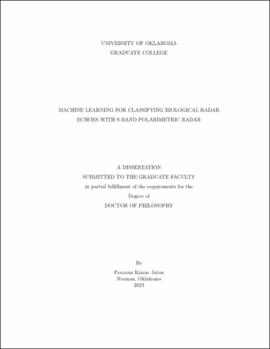| dc.description.abstract | The S-band WSR-88D weather radar is sensitive enough to observe biological
scatterers like birds and insects. However, their non-spherical shapes and frequent
collocation in the radar resolution volume create challenges in identifying their
echoes. We propose a method of extracting bird (or insect) features by coherently
averaging dual polarization measurements from multiple radar scans, containing
bird (insect) migration. Additional features are also computed to capture aspect
and range dependence, and the variation of these echoes over local regions.
Next, ridge classifier and decision tree machine learning algorithms are trained,
first only with the averaged dual pol inputs and then different combinations of the
remaining features are added. The performance of all models for both methods,
are analyzed using metrics computed from the test data. Further studies on differ-
ent patterns of birds/insects, including roosting birds, bird migration and insect
migration cases, are used to investigate the generality of our models. Overall, the
ridge classifier using only dual polarization variables was found to perform con-
sistently well across all these tests. Hereafter, this model is called the Bird-Insect
Ridge Classifier (BIRC).
Enhancements of the Velocity Azimuth Display (VAD) Wind Profile (VWP)
are explored by integrating BIRC to generate three new VAD products namely:
the insects-birds ratio, VAD focused on birds and insects focused VADs. Two
mains findings are drawn from experiments on these products. First, the insects-birds ratio is found to have an inverse relationship to wind biases, confirming bird
contamination as a cause of the latter. Second, VAD wind biases can be reduced
by focusing VAD on insects instead of all biological echoes.
It is recommended that BIRC can be used on the WSR-88D, for classifying
biological echoes from the HCA as birds or insects. Furthermore, the insects-birds
ratio, bird VAD and insect VAD products can be incorporated into the VWP. To
the best of our knowledge, this is the first machine learning classifier that has
been demonstrated to simultaneously classify diverse patterns of bird and insect
echoes, and improve clear-air VAD wind estimation by incorporating taxonomic
information. | en_US |
